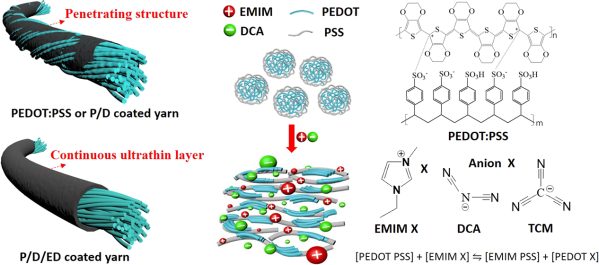Synergistically Improving Flexibility and Thermoelectric Performance of Composite Yarn by Continuous Ultrathin PEDOT:PSS/DMSO/Ionic Liquid Coating
ABSTRACT: Combining fabrics with a poly(3,4-ethylenedioxythiophene):poly(styrenesulfonate) (PEDOT:PSS) coating is the most promising method to fabricate wearable thermoelectric (TE) devices. However, the high modulus, low strain, and low TE performance of PEDOT:PSS coating lead to poor flexibility and low power generation efficiency. In this study, dimethyl sulfoxide (DMSO) and ionic liquids (ILs) were selected as a modifier to enhance the flexibility and TE performance of PEDOT:PSS. Different from the penetrating structure and coil conformation of pristine PEDOT:PSS coating, a flexible continuous ultrathin layer of PEDOT:PSS/DMSO/1-ethyl-3-methylimidazolium dicyanamide (P/D/ED) with a linear conformation forms on the surface of cotton yarn. The morphology and structure of PEDOT:PSS and P/D/ED coating were characterized by FESEM, XPS, and Raman spectroscopy. Compared with the pristine PEDOT:PSS film, the P/D/ED film shows significantly reduced modules and enhanced strain and bending stability. Moreover, the TE performance of P/D/ED-coated yarn is significantly enhanced with nearly half mass loading. Based on this, a large-area wearable TE fabric with enhanced flexibility and TE performance was prepared. The output power density is 136.1 mW/m2 at ΔT = 40.8 K, which is a typically high value compared with the former reported composite TE fabrics. This study provides a new way to synergistically enhance the flexibility and TE performance of composite yarn, and the prepared TE fabric has great potential as a wearable power source.

Li Mufang et al. Synergistically Improving Flexibility and Thermoelectric Performance of Composite Yarn by Continuous Ultrathin PEDOT: PSS/DMSO/Ionic Liquid Coating. ACS Applied Materials & Interfaces, 2021, 13, 50430-50440.